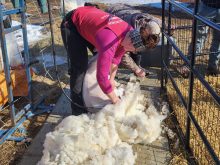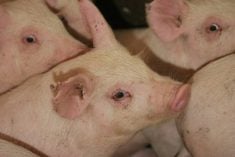WESTLOCK, Alta. – Hay is George and Joanne Dusseault’s livelihood, so quality is crucial.
In co-operation with their local Alberta Agriculture office, they’ve conducted hay storage trials on their Westlock farm for the last year to measure the hay wasted under various storage methods.
Their findings were shared during a recent agriculture service board tour of the municipal district of Westlock.
The farm produces round and square bales annually on 400 to 600 acres of hayland. With an almost fully mechanized system, they make about 15,000 straw and 20,000 hay bales each season. They haven’t grown grain in four years, relying entirely on a cow herd and hay sales for their living.
Read Also

Charges laid after cattle theft
Saskatchewan RCMP lay two charges against a man after six cattle went missing.
They used to grow a mixed grass hay but are switching to straight alfalfa and some timothy.
Brown considered waste
“You can sell it easier if it’s not mixed,” said George Dusseault.
The trial involved large, round bales weighing an average of 1,400 pounds. To check the quality after storage, bales were pulled apart and the spoiled hay was measured. For the purposes of their research, anything brown was considered waste.
The project involved wrappings as well as ground surface storage on gravel and grass. Gravel was the best surface for the bales.
Two samples saw bales bound with twine about six centimetres apart and another 18 centimetres apart with a tallow coating.
For the coating, fat is heated up and poured over the bales. It’s a method used in the United States to repel water but the Dusseaults found it had the opposite effect because the tallow coating held water on the hay.
“The tallow was a disaster. It looked awful,” said beef specialist Rod Carlyon who worked with the Dusseaults on this project.
On a 1,455-pound bale, set on gravel with twine spaced at about 18 centimetres and tallow applied, 174 pounds of hay was wasted on the top and 28 pounds on the bottom had to be discarded. Stored on grass, the waste was even higher.
Less waste was noted when bales were wrapped with twine closely spaced at six cm and then covered with a tarp.
Carlyon recommended creating an airspace between the tarp and the bales to keep moisture out.
This could be accomplished by placing a board between the bale and tarp cover. Set on a gravel surface, this wasted 40 pounds.
Favorite method
Dusseault’s favorite preservation method is a mesh plastic wrap which is wound around the bale by a special attachment on the baler. In his opinion the mesh pulls off easily and provides the most protection against weathering and spoilage.
An experiment this winter will involve piling round bales and then covering them with a tarp to prevent bleaching.
Discolored hay is often rejected by processors. At the same time they want a year-round supply of fresh-looking hay for their Asian customers.

















